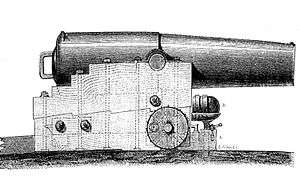Canon obusier



The Canon-obusier (literally "Shell-gun cannon", "gun-howitzer") was a type of cannon developed by France in the 1850s. The canon-obusier was a smoothbore cannon using either explosive shells, solid shot, or canister, and was therefore a vast improvement over previous cannon firing only solid shot, such as the Gribeauval system.
The very first canon-obusiers were naval shell guns, invented in 1823 by Paixhans and introduced in the French Navy in 1842.[1] This invention was related to the origin of the development of the Dahlgren shell gun in the United States in 1849.
The French Army introduced the canon-obusier de 12 in 1853. The US version of this type of canon-obusier, commonly called the "12-pounder Napoleon Model 1857", was one of the most-used cannon in the American Civil War.[2][3] Over 1,100 of these "Napoleons" were manufactured by the Union, and 600 by the Confederacy.[4]
The canon-obusier de 12 followed rifled cannons of the Treuille de Beaulieu system which had been introduced in 1858.[5]
The term "Canon-obusier" remained in use after World War I to designate various gun howitzers of the French Army.
See also
Notes
- ↑ A Treatise on Naval Gunnery By Howard Douglas p.432
- ↑ The Mitrailleuse by Dr. Patrick Marder Military History Online
- ↑ Nps.gov
- ↑ Nps.gov
- ↑ "...the introduction by the French army of the Beaulieu 4-pounder rifled field-gun in 1858: the new artillery, though much more accurate and long-ranged than the smoothbore 'canon-obusier' it replaced (which, incidentally, was the most prevalent artillery piece of the US Civil War), was not suited to firing anti-personnel case-shot (which, in French, is called 'mitraille')." in The Mitrailleuse by Dr. Patrick Marder Military History Online
